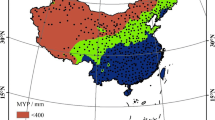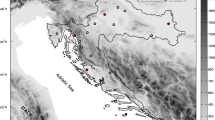Abstract
As shown by several authors, drought monitoring by the Standardized Precipitation Index (SPI) presents some uncertainties, mainly dependent on the choice of the probability distribution used to describe the cumulative precipitation and on the characteristics (e.g., length and variability) of the dataset. In this paper, the uncertainty related to SPI estimates has been quantified and analyzed with regards to the case study of the Abruzzo region (Central Italy), by using monthly precipitation recorded at 75 stations during the period 1951–2009. First, a set of distributions suitable to describe the cumulative precipitation at the 3-, 6-, and 12-month time scales was identified by using L-moments ratio diagrams. The goodness-of-fit was evaluated by applying the Kolmogorov–Smirnov test, and the Normality test on the derived SPI series. Then the confidence intervals of SPI have been calculated by applying a bootstrap procedure. The size of the confidence intervals has been considered as a measure of uncertainty, and its dependence on several factors such as the distribution type, the time scale, the record length, and the season has been examined. Results show that the distributions Pearson type III (PE3), Weibull (WEI), Generalized Normal (GNO), Generalized Extreme Value (GEV), and Gamma (GA2) are all suitable to describe the cumulative precipitation, with a slightly better performance of the PE3 and GNO distributions. As expected, the uncertainty increases as the record length and time scale decrease. The leading source of uncertainty is the record length while the effects due to seasonality and time scale are negligible. Two-parameter distributions make it possible to obtain confidence intervals of SPI (particularly for extreme values) narrower than those obtained by three-parameter distributions. Nevertheless, due to a poorer goodness of fit, two-parameter distributions can provide less reliable estimates of the precipitation probability. In any event, independently of the type of distribution, the SPI estimates corresponding to extreme precipitation values are always characterized by a relevant uncertainty. This is due to the explosion of the probability variability that occurs when precipitation values approach the tails of the supposed distribution.








Similar content being viewed by others
References
Abramowitz M, Stegun I. A 1965 Handbook of mathematical function, Dover: Editora, 1046p
Angelidis P, Maris F, Kotsovinos N, Hrissanthou V (2012) Computation of drought index SPI with alternative distribution functions. Water Resour Manag 26:2453–2473
Blain GC (2011) Standardized precipitation index based on Pearson type III distribution. Revista Brasileira de Meteorologia 26:167–180
Blain GC (2012a) Revisiting the probabilistic definition of drought: strengths, limitations and an agrometeorological adaptation. Bragantia Campinas 71(1):132–141
Blain GC (2012b) Monthly values of the standardized precipitation index in the state of São Paulo, Brazil: trends and spectral features under the normality assumption. Bragantia Campinas 71(1):460–470
Capasso M, Alessi L, Barigozzi M, Fagiolo G (2009) On approximating the distributions of goodness-of-fit test statistics based on the empirical distribution function: the case of unknown parameters. Adv Complex Syst 12(2):157–167
Di Lena B, Antenucci F, Vergni L, Mariani L (2013) Analysis of the climatic aggressiveness of rainfall in the Abruzzo region. Ital J Agrometeorology 1:33–44
Di Lena B, Vergni L, Antenucci F, Todisco F, Mannocchi F (2014) Analysis of drought in the region of Abruzzo (central Italy) by the standardized precipitation index. Theor Appl Climatol 115:41–52
Efron B, Tibshirani RJ (1993) An introduction to the bootstrap. Chapman and Hall
Hayes M, Svoboda M, Wall N, Widhalm M (2011) The Lincoln declaration on drought indices: universal meteorological drought index recommended. Bull Am Meteorol Soc 92:485–488
Guttman NB (1994) On the sensitivity of sample L moments to sample size. J Clim 7(6):1026–1029
Guttman NB, Hosking JRM, Wallis JR (1993) Regional precipitation quantile values for the continental United States computed from L-moments. J Clim 6:2326–2340
Guttman NB (1998) Comparing the Palmer drought index and the standardized precipitation index. J Am Water Resour Assoc 34:113–121
Guttman NB (1999) Accepting the standardized precipitation index: a calculation algorithm. J Am Water Resour As 35:311–322
Hosking JRM (1990) L-moments: analysis and estimation of distributions using linear combinations of order statistics. J R Stat Soc Series B 52:105–124
Hosking JRM, Wallis JR (1997) Regional frequency analysis. Cambridge University Press, Cambridge
Hu YM, Liang ZM, Liu YW, Wang J, Yao L, Ning Y (2015) Uncertainty analysis of SPI calculation and drought assessment based on the application of bootstrap. Int J Climatol 35:1847–1857
Lloyd-Hughes B, Saunders MA (2002) A drought climatology for Europe. Int J Climatol 22:1571–1592
McKee TBN, Doesken J, Kleist J (1993) The relationship of drought frequency and duration to time scales. Eight Conf On Applied Climatology Anaheim CA Amer Meteor Soc 179–184
Naresh Kumar N, Murthy CS, Sesha Saib MVR, Roy PS (2009) On the use of Standardized Precipitation Index (SPI) for drought intensity assessment. Meteorol Appl 16: 381–389
Naumann G, Barbosa P, Carrao H, Singleton A, Vogt J (2012) Monitoring drought conditions and their uncertainties in Africa using TRMM data. J Appl Meteorol Clim 51:1867–1874
Rebetez M, Helmut M, Olivier D, Dirk S, Karl G, Jürgen PK, Anette M (2006) Heat and drought 2003 in Europe: a climate synthesis. Ann For Sci 63:569–577
Ropelewski CF, Janowiak JE, Halpert MS (1985) The analysis and display of real time surface climate data. Mon Weather Rev 113:1101–1106
Soto LGM, Rutherford BM, Maarouf A (2005) Standardized precipitation index zones for México. Atmosfera 18(1):33–56
Vicente-Serrano SM (2006) Differences in spatial patterns of drought on different time scales: an analysis of the Iberian peninsula. Water Resour Manag 20:37–60
Vicente-Serrano SM, Beguería S, López-Moreno JI (2010) A multiscalar drought index sensitive to global warming: the standardized precipitation evapotranspiration index. J Clim 23:1696–1718
Vlček O, Huth R (2009) Is daily precipitation gamma-distributed? Adverse effects of an incorrect use of the Kolmogorov–Smirnov test. Atmos Res 93:759–766
Yue S, Hashino M (2007) Probability distribution of annual, seasonal and monthly precipitation in Japan. Hydrologic Sci J 52(5):863–877
Wilks DS, Eggleston KL (1992) Estimating monthly and seasonal precipitation distributions using the 30- and 90-day outlooks. J Clim 5:252–259
World Meteorological Organization (2012) Standardized Precipitation Index User Guide (M. Svoboda, M. Hayes and D. Wood). (WMO-No. 1090), Geneva
Wu H, Hayes MJ, Wilhite DA, Svoboda MA (2005) The effect of the length of record on the standardized precipitation index calculation. Int J Climatol 25:205–520
Wu H, Svoboda MD, Hayes MJ, Wilhite DA, Wen F (2007) Appropriate application of the standardised precipitation index in arid locations and dry seasons. Int J Climatol 27:65–79
Author information
Authors and Affiliations
Corresponding author
Rights and permissions
About this article
Cite this article
Vergni, L., Di Lena, B., Todisco, F. et al. Uncertainty in drought monitoring by the Standardized Precipitation Index: the case study of the Abruzzo region (central Italy). Theor Appl Climatol 128, 13–26 (2017). https://doi.org/10.1007/s00704-015-1685-6
Received:
Accepted:
Published:
Issue Date:
DOI: https://doi.org/10.1007/s00704-015-1685-6




